A Compact Dual Gamma Neutron Detector Based on NaI(Tl+Li) Scintillator Readout with SiPM
Abstract
:1. Introduction
2. Materials and Methods
2.1. Detector Design
2.2. Experimental Setup
2.3. Emission Spectrometry
3. Results and Discussion
3.1. Emissions Spectra
3.2. Energy Resolution and Linearity
3.3. Waveforms
3.4. Pulse Shape Discrimination
4. Conclusions
Author Contributions
Funding
Institutional Review Board Statement
Informed Consent Statement
Data Availability Statement
Conflicts of Interest
References
- Lee, C.; Yoon, S.; Won, B.; Seo, H.; Park, S.; Ahn, S. Comparative study of dual neutron/gamma scintillation detectors. J. Radioanal. Nucl. Chem. 2021, 330, 555–561. [Google Scholar] [CrossRef]
- Pérez-Loureiro, D.; Kamaev, O.; Bentoumi, G.; Li, L.; Jewett, C.; Thompson, M. Evaluation of CLYC-6 and CLYC-7 scintillators for detection of nuclear materials. Nucl. Instrum. Methods Phys. Res. Sect. A 2021, 1012, 165622. [Google Scholar] [CrossRef]
- Glodo, J.; Hawrami, R.; Shah, K.S. Development of Cs2LiYCl6 scintillator. J. Cryst. Growth 2013, 379, 73–78. [Google Scholar] [CrossRef]
- Glodo, J.; van Loef, E.; Hawrami, R.; Higgins, W.M.; Churilov, A.; Shirwadkar, U.; Shah, K.S. Selected Properties of Cs2LiYCl6, Cs2LiLaCl6, and Cs2LiLaBr6 Scintillators. IEEE Trans. Nucl. Sci. 2011, 58, 333–338. [Google Scholar] [CrossRef]
- McDonald, B.S.; Myjak, M.J.; Zalavadia, M.A.; Smart, J.E.; Willett, J.A.; Landgren, P.C.; Greulich, C.R. A wearable sensor based on CLYC scintillators. Nucl. Instrum. Methods Phys. Res. Sect. A 2016, 821, 73–80. [Google Scholar] [CrossRef] [Green Version]
- Glodo, J.; Hawrami, R.; van Loef, E.; Shirwadkar, U.; Shah, K.S. Pulse Shape Discrimination with Selected Elpasolite Crystals. IEEE Trans. Nucl. Sci. 2012, 59, 2328–2333. [Google Scholar] [CrossRef]
- Yang, K.; Menge, P.R. Pulse shape discrimination of Cs2LiYCl6:Ce3+ scintillator from −30 °C to 180 °C. Nucl. Instrum. Methods Phys. Res. Sect. A 2015, 784, 74–79. [Google Scholar] [CrossRef]
- Caifeng, L.; Jianguo, Q.; Jun, X.; Tonghua, Z.; Xinxin, L.; Li, A.; Yunfeng, M.; Pu, Z.; Junjie, S.; Li, J.; et al. Particle discrimination and fast neutron response for a NaIL:Tl and a NaI:Tl scintillator detector. Nucl. Instrum. Methods Phys. Res. Sect. A 2020, 978, 164372. [Google Scholar] [CrossRef]
- Liang, F.; Brands, H.; Hoy, L.; Preston, J.; Smith, J. Lithium-Loaded Scintillators Coupled to a Custom-Designed Silicon Photomultiplier Array for Neutron and Gamma-Ray Detection. IEEE Trans. Nucl. Sci. 2018, 65, 2162–2168. [Google Scholar] [CrossRef] [Green Version]
- Yang, K.; Menge, P.R.; Ouspenski, V. Li co-doped NaI:Tl (NaIL)—A Large Volume Neutron-Gamma Scintillator with Exceptional Pulse Shape Discrimination. IEEE Trans. Nucl. Sci. 2017, 64, 2406–2413. [Google Scholar] [CrossRef]
- Sangster, J.; Pelton, A.D. Phase Diagrams and Thermodynamic Properties of the 70 Binary Alkali Halide Systems Having Common Ions. J. Phys. Chem. Ref. Data 1987, 16, 509–561. [Google Scholar] [CrossRef]
- Tao, M.; Wang, Z.; Chen, Q.; Li, F.; Qi, J.; Qi, P.; Gao, T.; Zhao, Q.; Zhang, Z.; Zhu, B.; et al. Design and performance of a NaIL detector for neutron/gamma discrimination. J. Instrum. 2021, 16, P08067. [Google Scholar] [CrossRef]
- Huang, T.; Fu, Q.; Lin, S.; Wang, B. NaI(Tl) scintillator read out with SiPM array for gamma spectrometer. Nucl. Instrum. Methods Phys. Res. Sect. A 2017, 851, 118–124. [Google Scholar] [CrossRef]
- Huang, T.; Fu, Q.; Yuan, C.; Lin, S. A gamma and neutron phoswich read out with SiPM for SPRD. Nucl. Instrum. Methods Phys. Res. Sect. A 2018, 881, 48–52. [Google Scholar] [CrossRef]
- Huang, T.; Zhang, Z. Characterization of 1-inch CLYC scintillator coupled with 8 × 8 SiPM array. Nucl. Instrum. Methods Phys. Res. Sect. A 2021, 999, 165225. [Google Scholar] [CrossRef]
- Shen, F.; Pan, Y.; Fu, Q.; Lin, S.; Huang, T.; Wang, W. PSD performance of EJ-276 and EJ-301 scintillator readout with SiPM array. Nucl. Instrum. Methods Phys. Res. Sect. A 2022, 1039, 167148. [Google Scholar] [CrossRef]
- Del Guerra, A.; Belcari, N.; Giuseppina Bisogni, M.; LLosa, G.; Marcatili, S.; Ambrosi, G.; Corsi, F.; Marzocca, C.; Dalla Betta, G.; Piemonte, C. Advantages and pitfalls of the silicon photomultiplier (SiPM) as photodetector for the next generation of PET scanners. Nucl. Instrum. Methods Phys. Res. Sect. A 2010, 617, 223–226. [Google Scholar] [CrossRef]
- Carnesecchi, F.; Agrawal, N.; Alici, A.; Antonioli, P.; Arcelli, S.; Basile, M.; Bellini, F.; Cavazza, D.; Cifarelli, L.; Cindolo, F.; et al. Experimental study of the time resolution of SiPM coupled to scintillator. Nucl. Instrum. Methods Phys. Res. Sect. A 2020, 982, 164484. [Google Scholar] [CrossRef]
- Zhang, Z.; Wang, D.; Feng, S.; Ye, Z.; Zhou, T.; Zheng, Z.; Wang, F.; Zhao, C.; Wang, Z.; Bai, L.; et al. A portable neutron gamma discrimination detector based on NaIL and SiPM. J. Instrum. 2022, 17, T06005. [Google Scholar] [CrossRef]
- Grodzicka, M.; Moszynski, M.; Szczesniak, T.; Szawlowski, M.; Baszak, J. Characterization of 4 × 4 ch MPPC array in scintillation spectrometry. J. Instrum. 2013, 8, P09020. [Google Scholar] [CrossRef]


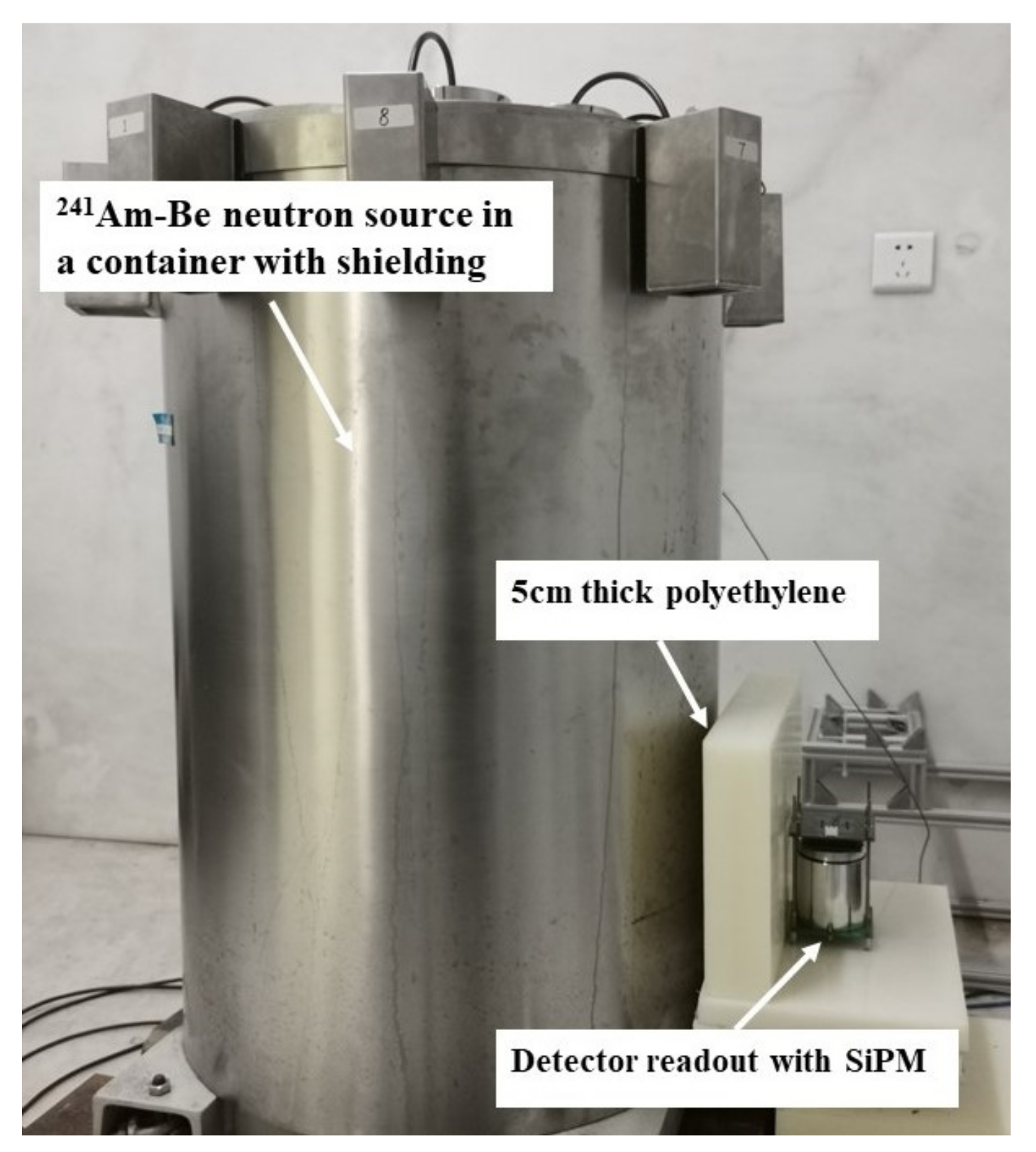
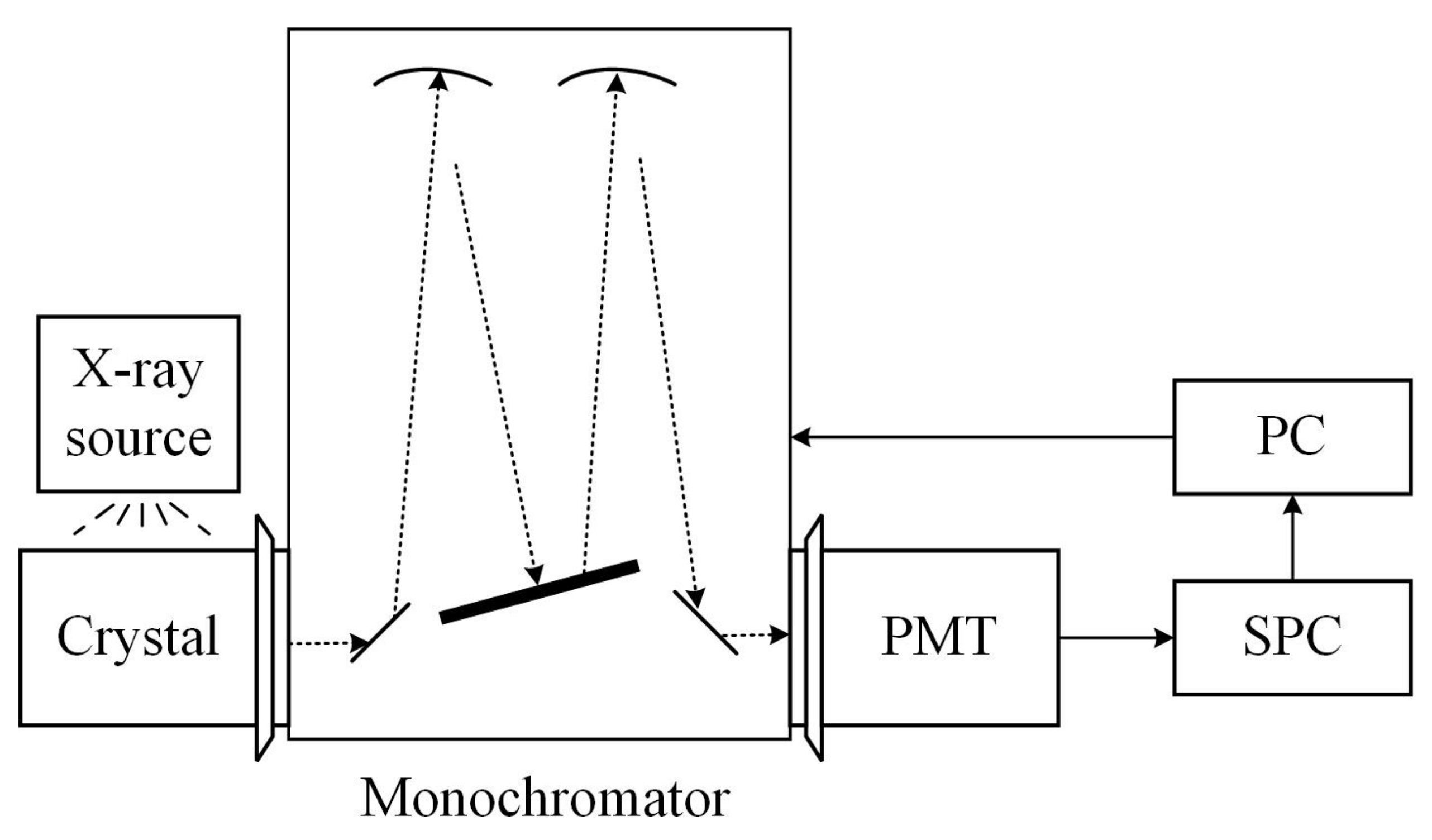
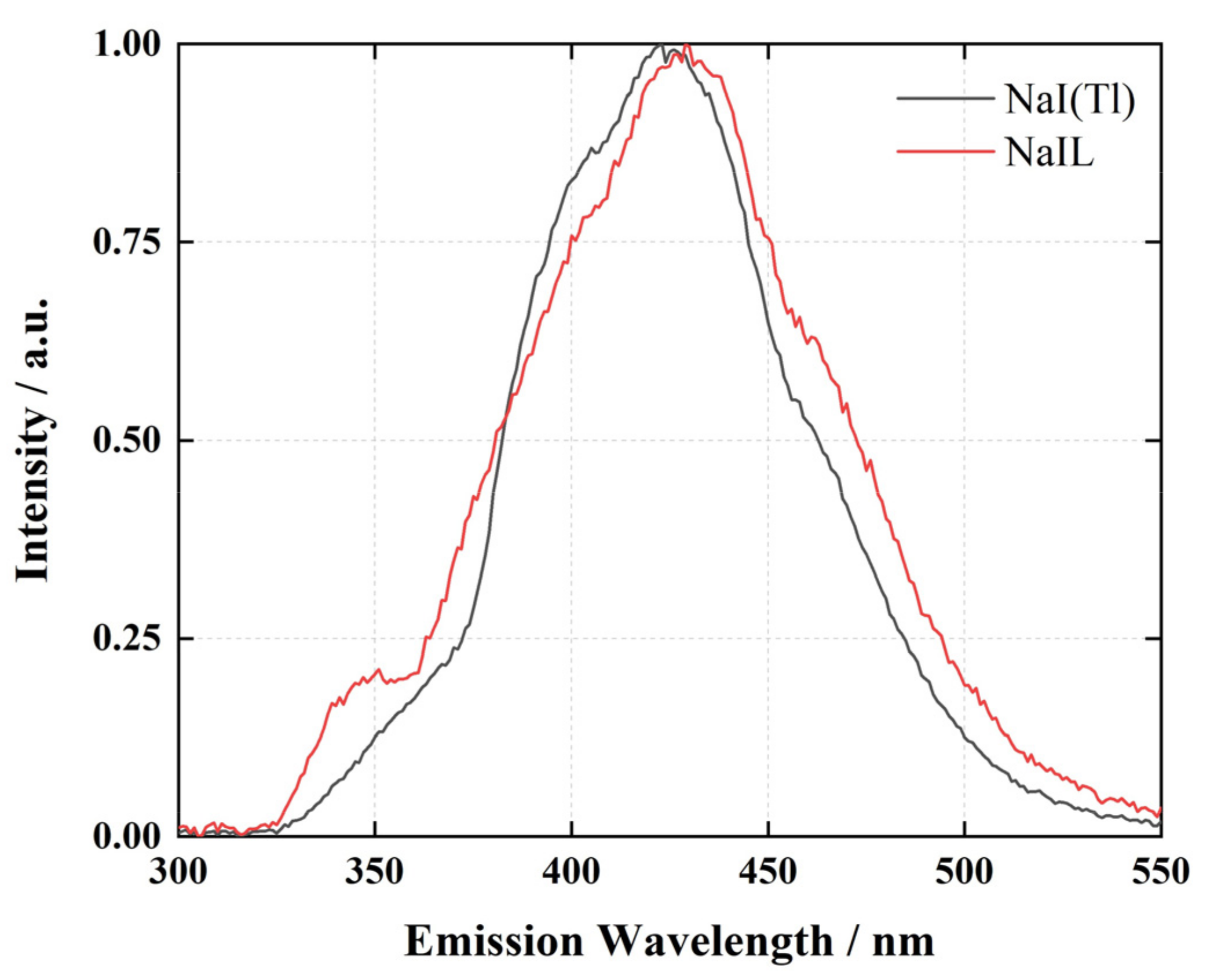
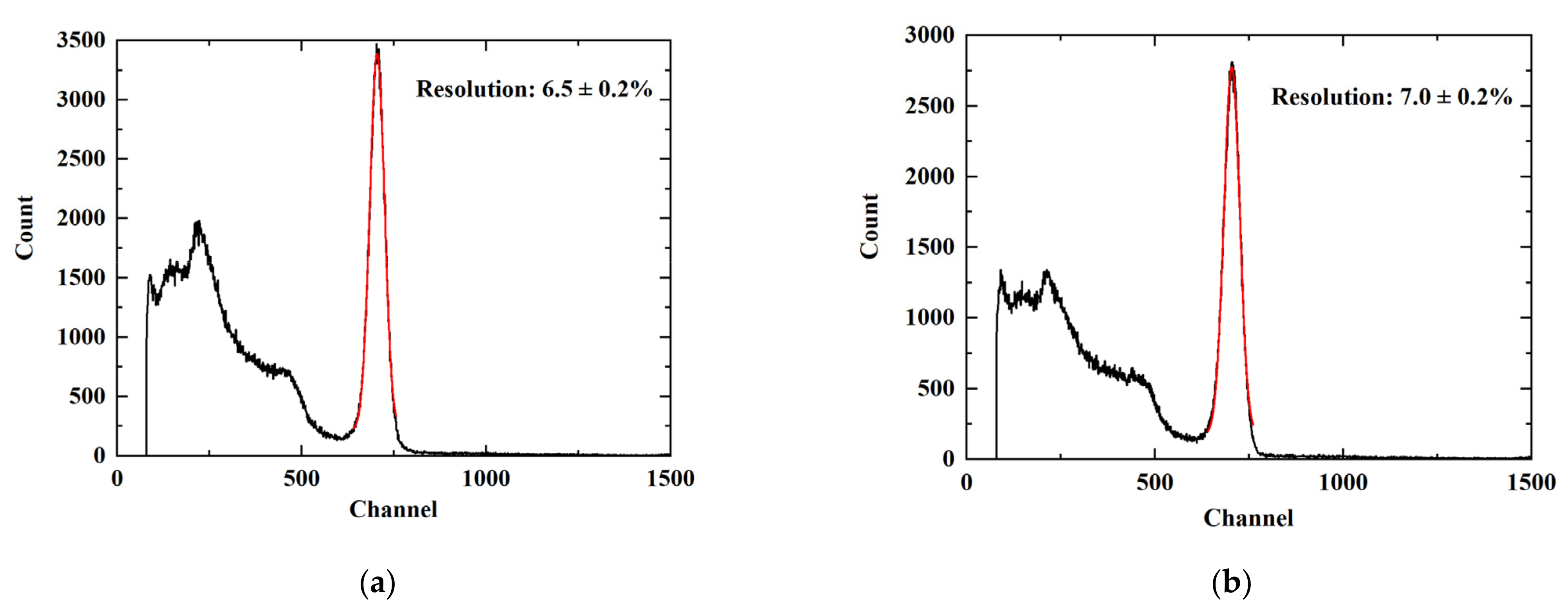
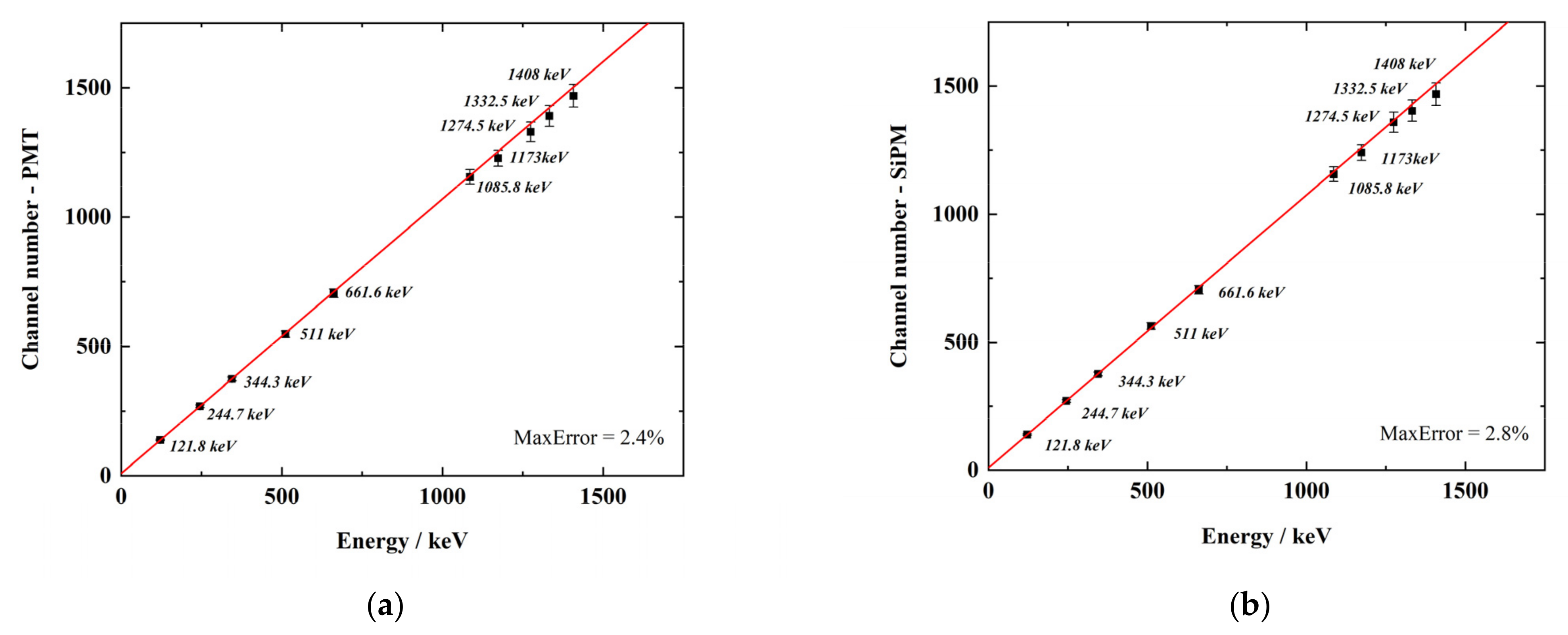


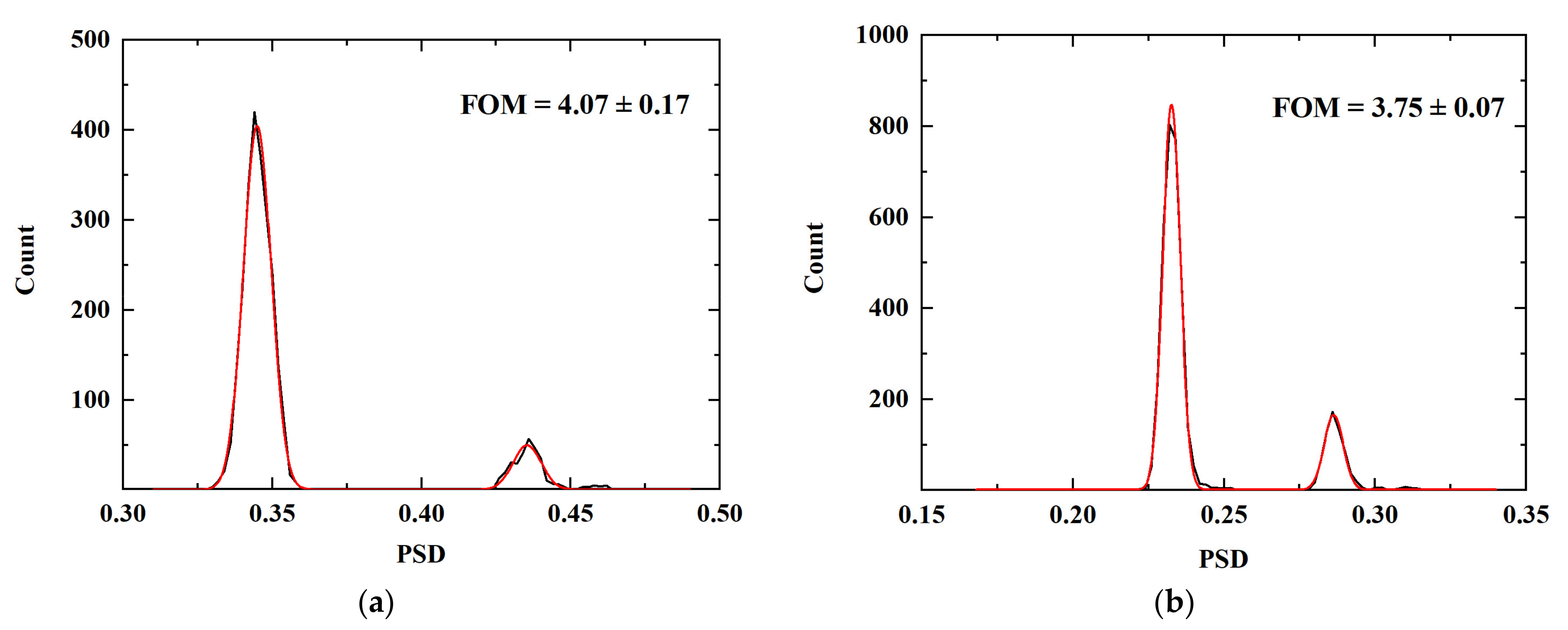
| Manufacturer | SensL |
|---|---|
| Model | ArrayJ-60035-64P |
| Number of channels | 64 (8 × 8 ch) |
| Active area/channel | 6.07 mm × 6.07 mm |
| Number of APD cells/channel | 22,292 |
| Total number of APD cells | 1,426,688 |
| APD cell size | 35 µm × 35 µm |
| Microcell fill factor | 75% |
| Rated gain | 2.9 × 106 (VOV = 2.5V) |
| Spectral range | 200–900 nm |
| Maximum sensitivity | 420 nm |
| Photon detection efficiency (PDF) | 38% (VOV = 2.5V, λ = 420 nm) |
Publisher’s Note: MDPI stays neutral with regard to jurisdictional claims in published maps and institutional affiliations. |
© 2022 by the authors. Licensee MDPI, Basel, Switzerland. This article is an open access article distributed under the terms and conditions of the Creative Commons Attribution (CC BY) license (https://creativecommons.org/licenses/by/4.0/).
Share and Cite
Shen, F.; Fu, Q.; Huang, T.; Wang, W. A Compact Dual Gamma Neutron Detector Based on NaI(Tl+Li) Scintillator Readout with SiPM. Crystals 2022, 12, 1077. https://doi.org/10.3390/cryst12081077
Shen F, Fu Q, Huang T, Wang W. A Compact Dual Gamma Neutron Detector Based on NaI(Tl+Li) Scintillator Readout with SiPM. Crystals. 2022; 12(8):1077. https://doi.org/10.3390/cryst12081077
Chicago/Turabian StyleShen, Fengzhao, Qibin Fu, Tuchen Huang, and Wei Wang. 2022. "A Compact Dual Gamma Neutron Detector Based on NaI(Tl+Li) Scintillator Readout with SiPM" Crystals 12, no. 8: 1077. https://doi.org/10.3390/cryst12081077
APA StyleShen, F., Fu, Q., Huang, T., & Wang, W. (2022). A Compact Dual Gamma Neutron Detector Based on NaI(Tl+Li) Scintillator Readout with SiPM. Crystals, 12(8), 1077. https://doi.org/10.3390/cryst12081077






